Kathakali: Unveiling the Spectacular Dance-Drama of Kerala’s Mythical Tales

Kathakali, a traditional Indian dance-drama form, transports its audience to a mesmerizing realm of mythological tales and expressive movements. Hailing from the picturesque state of Kerala, Kathakali holds a significant place in India’s rich cultural heritage. This article delves into the enchanting world of Kathakali, unraveling its origins, unique elements, mythological narratives, training process, cultural significance, and contemporary relevance.
Rooted in ancient traditions, Kathakali encompasses a fascinating blend of dance, music, and acting. Through meticulously choreographed performances, Kathakali artists skilfully bring to life characters from revered epics such as the Mahabharata and the Ramayana. Each element of Kathakali, from the elaborate makeup to the intricate hand gestures and vibrant costumes, contributes to its visual splendour and emotional depth.
Kathakali derives its name from two Sanskrit words: “Katha,” meaning story, and “Kali,” referring to performance. Together, they encapsulate the essence of this art form as a means of storytelling through powerful expressions and movements. The origins of Kathakali can be traced back centuries, evolving from a synthesis of several traditional dance and theatre forms prevalent in South India.
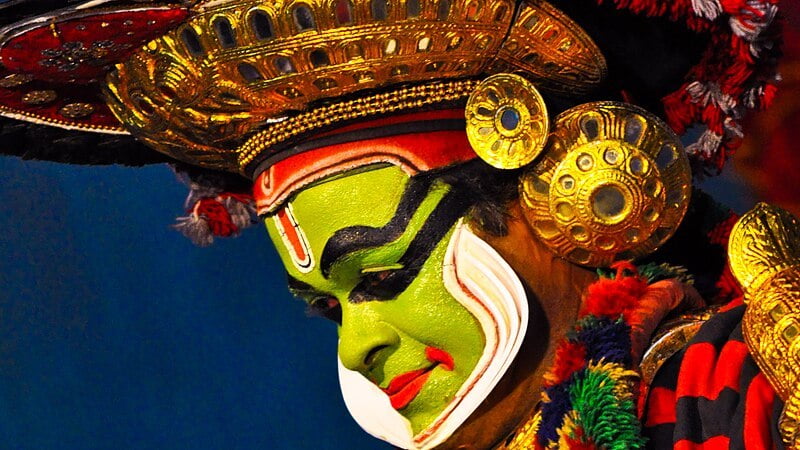
Throughout its history, Kathakali has been shaped by cultural and religious influences. The art form has absorbed elements from Koodiyattam, a Sanskrit theatre tradition, and martial arts practices like Kalaripayattu. These influences have contributed to Kathakali’s distinctive aesthetic and its ability to convey complex emotions, larger-than-life characters, and profound narratives.
Intricate facial makeup, known as “chutti,” plays a crucial role in Kathakali performances. The colourful and intricate designs on the faces of the performers enhance the visual impact and help distinguish characters based on their attributes, such as noble heroes, devious demons, or virtuous gods. The makeup process itself is an art, requiring skill and precision in its application.

Hand gestures, or “mudras,” are another integral aspect of Kathakali. The dancers employ a vast repertoire of mudras, each carrying symbolic meaning and representing various emotions, objects, and characters. These intricate hand movements, combined with eye expressions and facial contortions, allow the dancers to communicate and convey a wide range of emotions and narratives.
Kathakali’s physicality extends beyond the hands, encompassing dynamic footwork and graceful body movements. The dancers undergo years of rigorous training to perfect their techniques, honing their ability to tell stories through their bodies. The synchronized footwork, characterized by rhythmic stomping and precise positioning, adds a rhythmic dimension to the performance, enhancing its overall artistic impact. As an art form deeply rooted in Indian mythology and folklore, Kathakali serves as a cultural bridge, connecting generations and preserving ancient narratives. Its performances are often held during festive occasions and temple rituals in Kerala, reflecting the cultural and religious traditions of the region. The art form continues to captivate audiences worldwide, earning acclaim for its artistic prowess and expressive storytelling.
Origins and History
Kathakali, with its rich history and cultural significance, traces its roots back to the ancient art forms of Kerala, a southern state of India. The origins of Kathakali can be found in the religious rituals and theatrical traditions that were prevalent in the region. The development of Kathakali can be attributed to the amalgamation of various art forms that existed in Kerala. One of the major influences was Koodiyattam, a Sanskrit theatre tradition that dates back over 2,000 years. Koodiyattam, known for its highly stylized performances and elaborate makeup, contributed to the visual aesthetics and dramatic elements of Kathakali.
Another influential art form was Krishnanattam, a dance-drama based on the life of Lord Krishna. This 8th-century work by the poet Kulasekhara Varma, the king of Travancore, served as a foundation for the musical and narrative structure of Kathakali. It provided a repertoire of stories from the Hindu epics that would later become central to Kathakali performances.
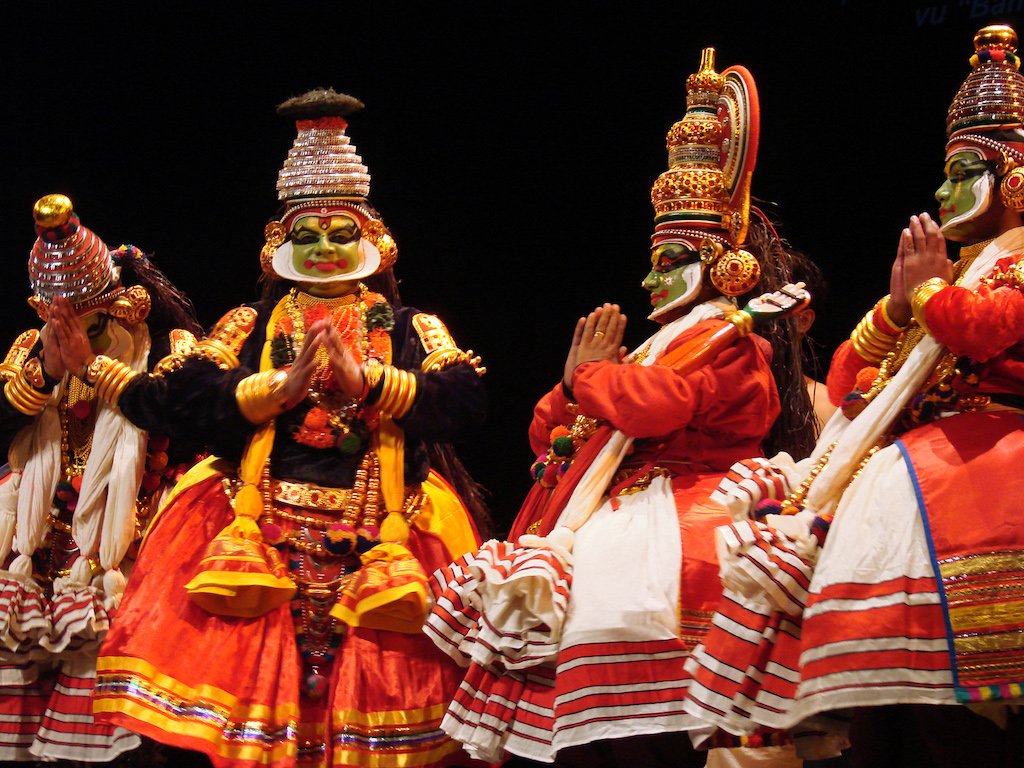
Over time, Kathakali absorbed elements of traditional martial arts, particularly Kalaripayattu, which enhanced the physicality and athleticism of the performers. The rigorous training in Kalaripayattu contributed to the dancers’ flexibility, strength, and control, allowing them to execute the demanding movements and acrobatic sequences that are characteristic of Kathakali.
The 17th century marked a significant milestone in the evolution of Kathakali. It was during this period that the art form underwent a transformation, with the introduction of “Ramanattam” by Kottarakkara Thampuran, the ruler of the principality of Kottarakkara. Ramanattam, based on the epic Ramayana, shifted the focus from the divine to human characters, allowing for greater emotional depth and relatability in the performances.
Elements of Kathakali: A Visual and Expressive Extravaganza
One of the most striking features of Kathakali is its elaborate facial makeup, known as “chutti.” The application of chutti involves intricate designs using natural colours derived from rice paste and vegetable dyes. The makeup serves multiple purposes: it enhances the facial expressions of the performers, helps portray different characters, and visually amplifies the emotions they represent. The chutti patterns are meticulously crafted, with each colour and line having symbolic significance.
The facial makeup is accompanied by vibrant costumes that are an integral part of Kathakali’s visual appeal. The performers adorn richly embroidered and brightly coloured attire, often featuring elaborate headgear and jewellery. The costumes distinguish various characters, with different colours and styles representing gods, heroes, heroines, and demons. The combination of intricate makeup and elaborate costumes creates a visually stunning and immersive experience for the audience.
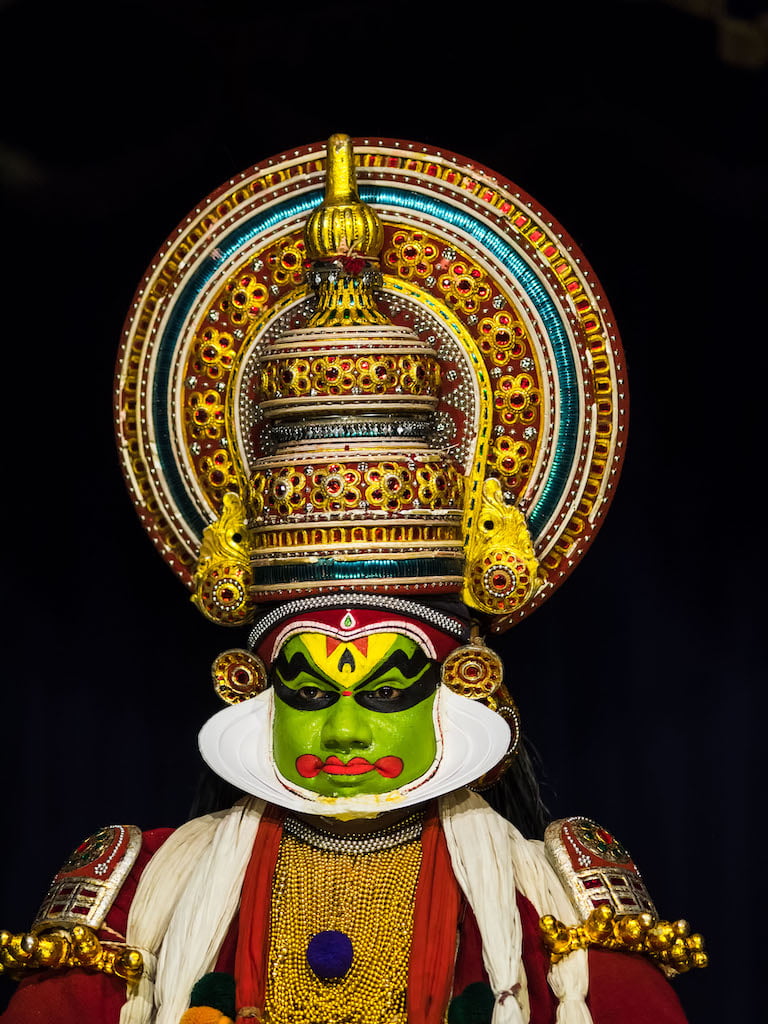
Hand gestures, or “mudras,” play a vital role in Kathakali performances. The dancers employ a vast repertoire of mudras, each representing a specific emotion, object, or character. These gestures, performed with precision and coordination, serve as a distinct language within Kathakali. Mudras are executed with the hands, fingers, and wrists, and their symbolism adds depth and clarity to the storytelling aspect of the dance-drama. The intricate combinations of mudras contribute to the overall beauty and expressive power of the performance.
Eye movements, known as “netrabhinaya,” form a crucial component of Kathakali’s expressive vocabulary. The performers are trained in the art of moving their eyes independently, allowing them to convey a wide range of emotions and expressions. The eyes, often painted prominently on the performers’ faces, enable the audience to connect with the characters at a profound level. From conveying anger and love to depicting sorrow and joy, the nuanced eye movements add layers of complexity to the storytelling and emotional portrayal in Kathakali.
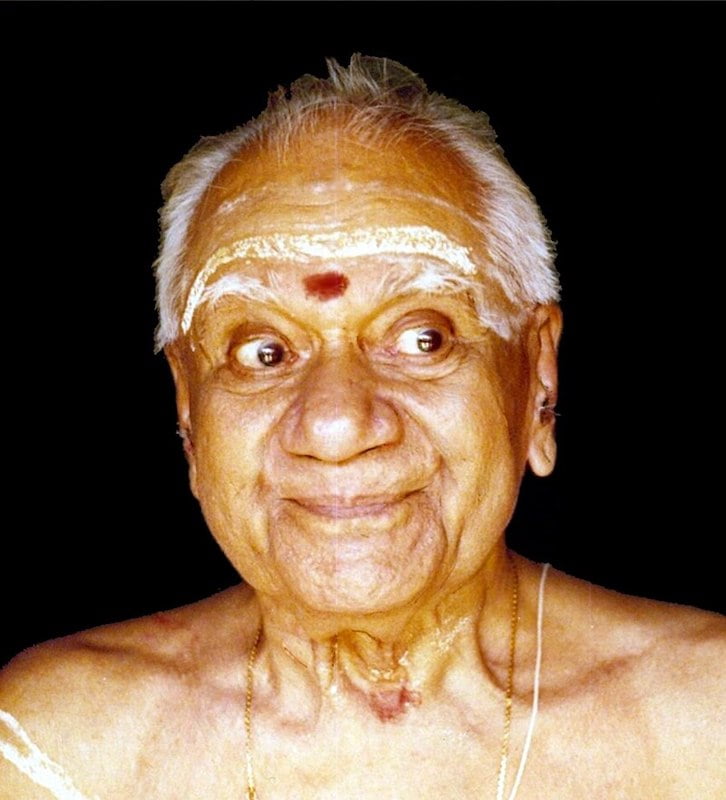
Footwork and body movements in Kathakali are marked by precision, strength, and grace. The performers execute intricate footwork patterns, creating rhythmic beats with their steps. The movements are characterized by leaps, jumps, and controlled turns, displaying the dancers’ athleticism and stamina. The body movements, including postures and gestures of the torso and limbs, are meticulously choreographed to convey the physicality, emotions, and narrative of the characters.
The musical accompaniment in Kathakali, known as “Sopanam,” enhances the overall impact of the performances. Sopanam consists of vocalists singing verses in a distinct style, accompanied by traditional percussion instruments like the chenda, maddalam, and elathalam. The music sets the mood, rhythm, and pace of the performance, complementing the dancers’ movements and expressions.
Together, these elements create a unique and enchanting experience for the audience, immersing them in the world of Kathakali’s mythological tales and dramatic narratives. The elaborate makeup, vibrant costumes, intricate hand gestures, expressive eye movements, dynamic footwork, and captivating music converge to form a mesmerizing spectacle that engages and transports the viewers.
Mythological Stories and Characters: Epics Unleashed in Kathakali
Rooted in ancient Indian epics like the Mahabharata and the Ramayana, Kathakali brings to life gods, goddesses, heroes, heroines, and demons with extraordinary theatrical flair. These mythological tales serve as a source of inspiration, moral guidance, and entertainment, captivating audiences across generations.
One of the most revered characters in Kathakali is Lord Rama, the noble prince and protagonist of the Ramayana. Through powerful expressions, graceful movements, and a dignified demeanour, Kathakali artists embody the virtuous and courageous qualities of Lord Rama, depicting his triumphs, challenges, and unwavering devotion.
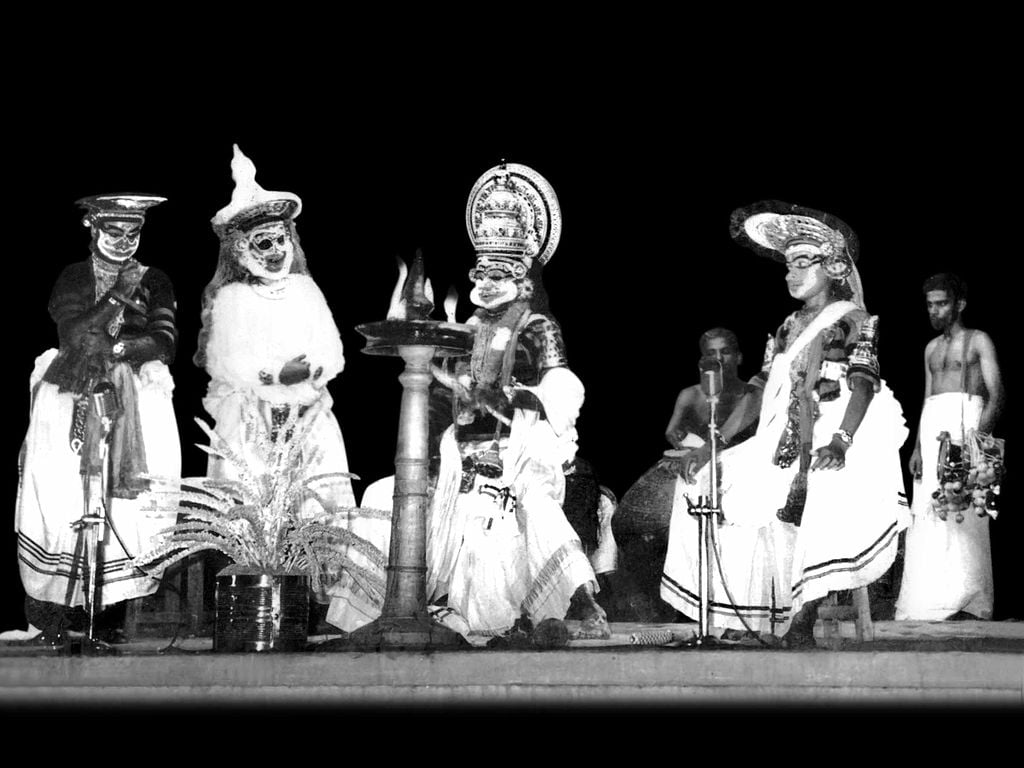
The demon king Ravana, an antagonist in the Ramayana, is portrayed with equal intensity. With fierce expressions, exaggerated features, and thunderous footwork, Kathakali artists capture the menacing aura and larger-than-life presence of Ravana, showcasing his arrogance, power, and eventual downfall.
Kathakali also brings forth characters from the Mahabharata, one of the longest epic poems in the world. Arjuna, the skilled archer and warrior, is depicted with grace, agility, and fluid movements, illustrating his prowess on the battlefield. His internal conflicts and moral dilemmas are conveyed through subtle nuances in facial expressions and body language.
Another prominent character from the Mahabharata is Duryodhana, the ambitious and treacherous antagonist. Kathakali artists portray Duryodhana’s vengeful nature and inner turmoil through aggressive movements, piercing glances, and powerful gestures, evoking both fear and fascination.
The divine feminine finds expression in characters like Sita, the devoted wife of Lord Rama, and Draupadi, the queen of the Pandavas in the Mahabharata. Kathakali celebrates the strength, beauty, and resilience of these iconic women, showcasing their unwavering loyalty, unwavering courage, and unyielding spirit through graceful movements and emotive expressions.
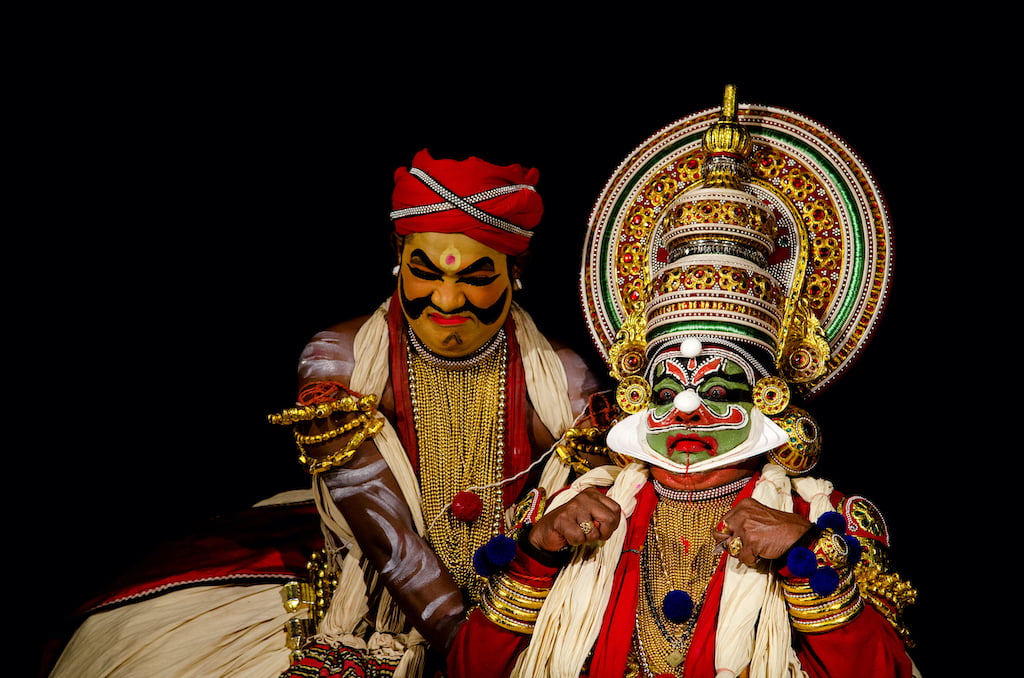
Not only does Kathakali portray gods, heroes, and heroines, but it also brings to life a myriad of mythical creatures and demons. Characters like Hanuman, the monkey god, and the ten-headed demon king, Ravana, are portrayed with extraordinary physicality, showcasing their unique attributes and roles in the epic narratives.
Through their performances, Kathakali artists breathe life into these characters, embodying their essence and bringing forth their virtues, flaws, and complexities. The elaborate makeup, costumes, and gestures combine to transform the dancers into living embodiments of mythological legends, captivating the audience with their power and artistry.
Kathakali’s portrayal of these mythological stories and characters goes beyond entertainment. It serves as a medium for moral education, spiritual exploration, and cultural preservation. The narratives resonate with universal themes of love, honour, sacrifice, and the eternal battle between good and evil, offering profound insights into the human condition.
Training and Performance: Mastering the Art of Kathakali
Training in Kathakali begins at a young age, often in specialized institutions called “Kala Mandapams.” Aspiring dancers, known as “Kalari,” undergo a holistic and comprehensive training regimen that encompasses physical conditioning, expressive techniques, and the mastery of Kathakali’s intricate movements.
Physical fitness is a cornerstone of Kathakali training. Kalari undergo rigorous exercises and body conditioning techniques to develop strength, stamina, and flexibility. These exercises, often influenced by the martial art form Kalaripayattu, enhance the dancers’ physicality and enable them to execute the demanding footwork, leaps, and jumps that are characteristic of Kathakali.
One of the fundamental aspects of Kathakali training is the mastery of “abhinaya” – the art of expression. Kalari learn to communicate emotions, narratives, and characters through a rich vocabulary of facial expressions, eye movements, and body gestures. Expressive training involves intense practice to convey a range of emotions, from love and anger to sorrow and joy, with clarity and depth.
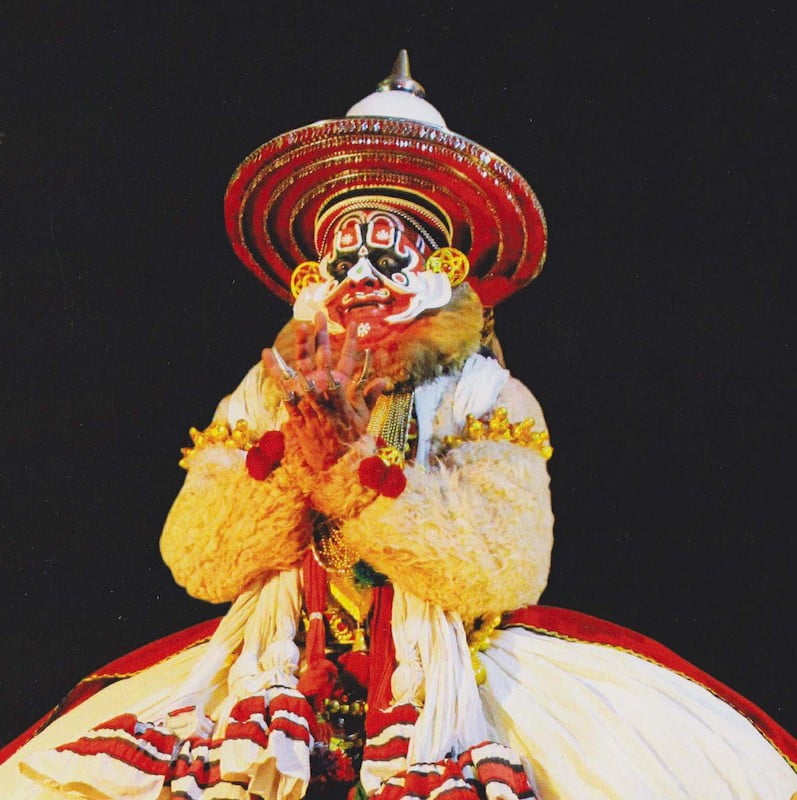
Hand gestures, or “mudras,” play a crucial role in Kathakali. Kalari spend years perfecting the intricate mudra sequences, each carrying its own meaning and symbolism. The art of combining mudras with facial expressions and body movements is meticulously honed, allowing the dancers to articulate complex narratives and evoke powerful emotions through their gestures.
Eye movements, or “netrabhinaya,” form an essential aspect of Kathakali’s expressive repertoire. Kalari undergo specialized training to develop the ability to move their eyes independently, enabling them to convey a wide range of emotions and create mesmerizing visual compositions. The eye movements, combined with facial expressions, enhance the storytelling and add depth to the characters portrayed.
Kathakali performances are typically structured as a series of individual acts, called “vachikabhinaya,” interspersed with dance sequences, known as “nritya.” The synchronized footwork, dynamic leaps, and controlled turns require impeccable timing, precision, and coordination. Kalari devote countless hours to mastering these movements, ensuring their execution is both technically proficient and aesthetically captivating.
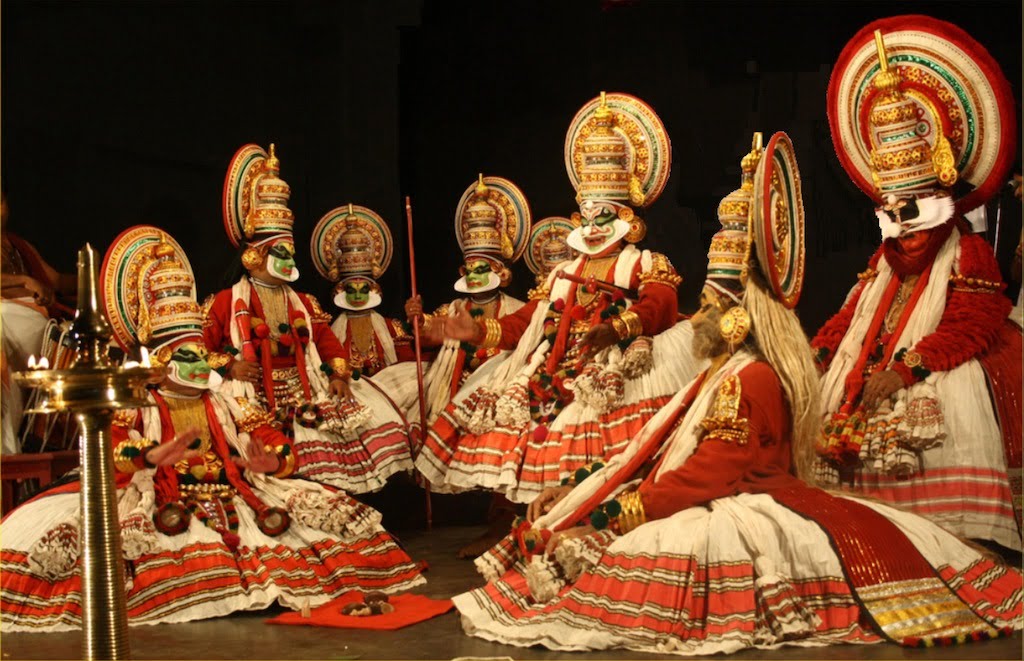
Apart from the physical and expressive training, Kalari also receive instruction in the theoretical aspects of Kathakali. They study the traditional repertoire of stories, the symbolism embedded within the movements and costumes, and the musical nuances that accompany the performances. This knowledge deepens their understanding of the art form and enriches their portrayal of characters and narratives.
The culmination of years of training is seen in the awe-inspiring performances of Kathakali artists. The dancers, through their intricate makeup, vibrant costumes, evocative expressions, and captivating movements, transport the audience to the mythological world they depict. The synergy between the performers, the music, and the audience creates an immersive experience that resonates with the cultural heritage of Kerala.
Kathakali is not merely a dance form; it is a way of life. The dedicated training, discipline, and commitment required to master the art form shape the dancers into consummate performers who embody the essence of the mythological characters they portray. Their artistry not only entertains but also preserves the rich cultural heritage of India.





